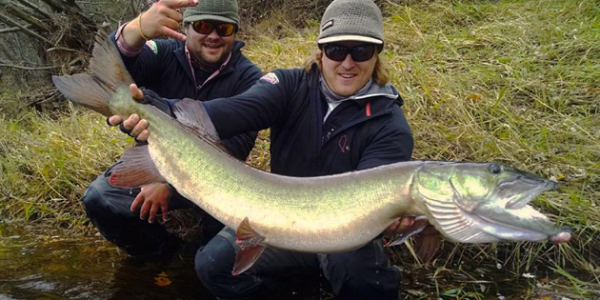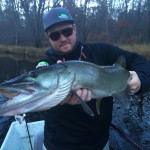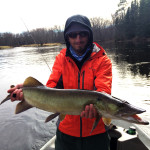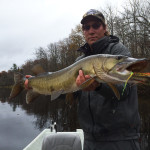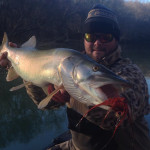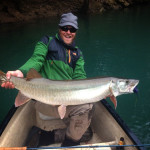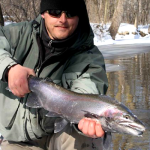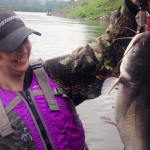By Chris Willen
When most people think about late season and cold water musky fishing they think giant rubber and suckers being dragged beneath a bobber. Although both are amazing ideas, I’m here to tell you there’s another method worth adding to the list.
Stripping big flies with heavy sinking lines is an option that not too many people in the musky world are utilizing. Sure, it takes a little while getting used to throwing 450 grains of sinking line, but when you get it dialed you’ve just opened up a whole different door to catching musky. This will give you a huge leg up on all the other boats on your favorite waters chasing a giant everyone wants to get a grip and grin with.
Live bait will always be effective, there’s no denying that. But moving fish to your boatside suckers isn’t always an easy game, or convenient. So using the fly rod as a tool to get fish moving is a good option on the days that even the sucker floats aren’t going down.
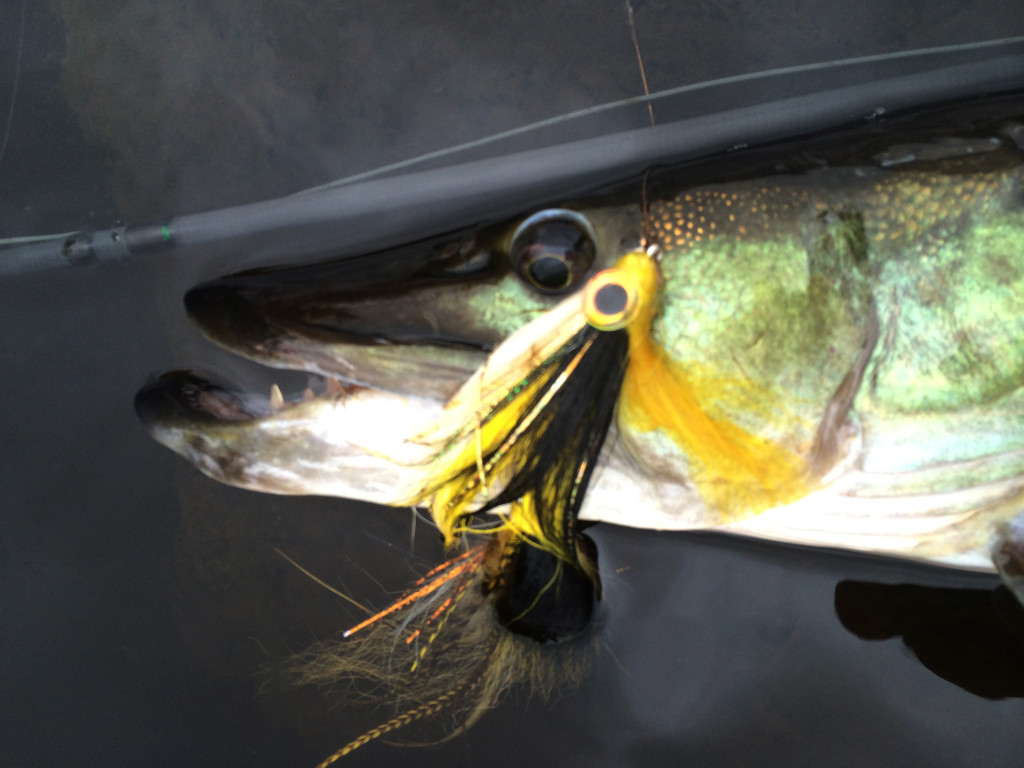
When I used to only cast traditional musky gear I would always lead my lure to my boat side sucker and pretty much forgo any figure 8 or boat side maneuvers. Hell, I just spent $10 on this giant minnow, and I want to see it get crushed! Same will work with your fly rod. Strip your fly right to your sucker and make another cast. The musky you’re hunting might not move to that bulldawg but it might get curious about that wispy fly deal going over its head and now you’ve begun your trap. You might not get your fly to your sucker that I’m sure you’ve given some clever name to, I know I do. Rather, the musky might just engulf your fly instead. Then you’ve really got a fun fight on your hands and some bragging rights when you tell your buddies you landed a nice musky on a fly rod.
Assuming your game doesn’t involve suckers and you just want to only catch them on flies. Perfect! Now you can really get in depth with your techniques for capturing musky on the fly rod.

Chris Willen with Mike Schultz, of Schultz Outfitters Michigan, with one of Willen’s largest guided river muskies of the 2014 season.
One of the main things you need to do is slow down. Most people want to make as many casts as possible while musky fishing, covering the water, and why not. Well with flies it’s a different game. Your thought process should be to cover water more effectively instead. Therefore making sure you’ve completely beaten up an area before moving onto the next one. This is a much slower game; we’re catching musky on fly rods here. You have to do the work.
Slow stripping a fly back in, getting it to come in deep and giving a musky plenty of time to eat is the method. SLOWLY bring your fly back to the boat with the tip of your fly rod actually in the water. Doing so you’ll achieve more depth and you’ll have an easier transition to your figure 8.
Figure 8 maneuvers with fly rods are huge in late season musky fishing. After every cast you should attempt to make a boat side move like you would with conventional gear. In late season I like to lower my rod tip down and perform deeper figure 8 turns than I normally would. For this time of season always think low and slow. This is where the angler in the back of the boat can really dig down and bring his fly in much slower than that guy in the front. It doesn’t always pay to go through a section first.
The biggest hurdle through all of this is going to be setting the hook. For some reason unbeknownst to me it seems that when muskies feed late season they want to swim right at you, more frequently in rivers but lakes also. This means the already difficult task of driving the fly and setting the hook becomes more advanced. This is where the seasoned fly angler will show what his or her skills are made of. Fact of the matter is you’re probably going to mess up a few before you land one.
When it comes to setting the hooks deep, I’m going to tell you exactly what you need to do. But there’s a learning curve no doubt. Imagine you’re slowly stripping the fly and you feel something. What you must do is point the rod tip straight at the fish and begin strip setting as hard as you can, as quickly as possible. You need to drive that 5/0 hook through the muskies mouth by pulling the line rather than setting with the rod. If you set with the rod the game is over and you’ll have to start counting to 10,000 again. I have seen so many fish come off because anglers set with the rod. It doesn’t work, and will not work. You might have the fish on for a short time but it will spit the fly eventually.
Good solid strip setting is the key to success. As mentioned this is the hardest part to successful fly fishing. Spring, summer, fall and winter, musky fishing a strip set is what you need to condition yourself to do. Many years of conventional fishing will come back to haunt you on this topic, but rod setting is the enemy.
There’s two big techniques to remember when late season musky fishing. SLOW DOWN and STRIP SET. You will get more fish into the boat with more techniques you learn. Don’t settle for what you already don’t do. Catch more fish, and catch bigger fish to broaden your musky fishing horizons.
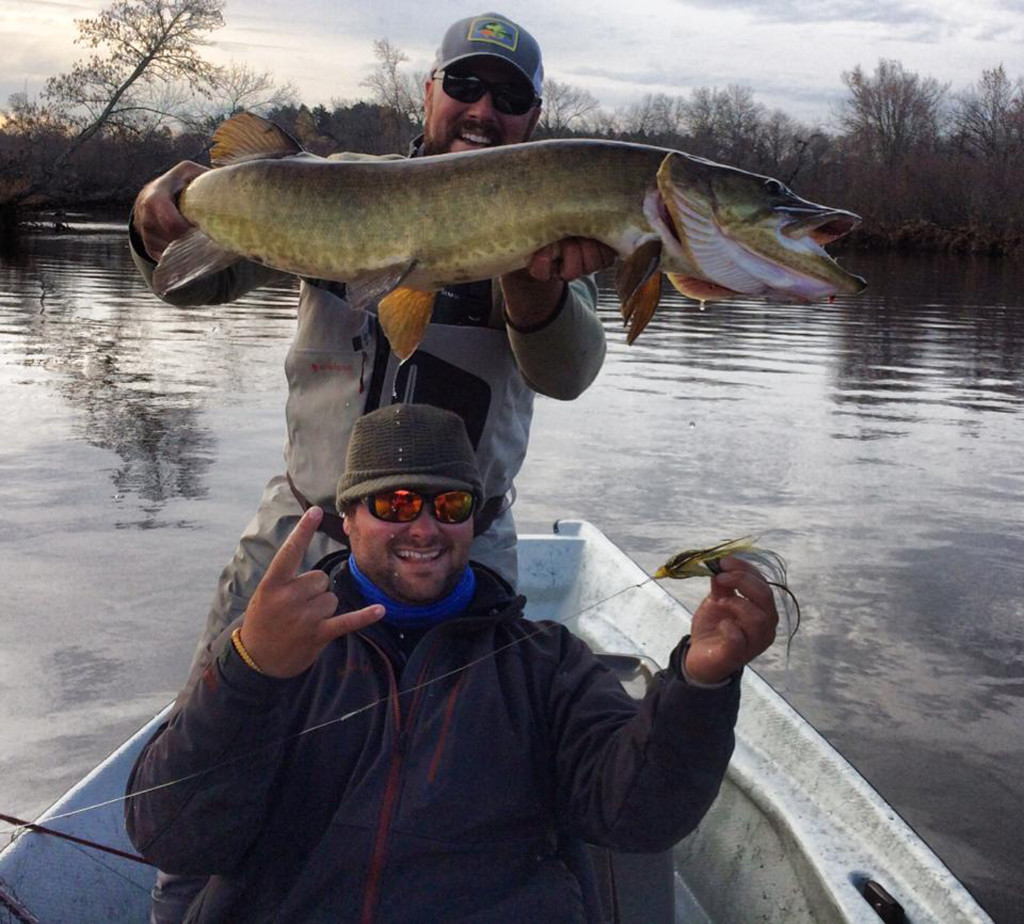
Chris Willen has been musky fishing for well over a decade, from the freestone rivers of the Upper Midwest to the limestone rivers of the Cumberland plateau and most places in between. One of the things he has enjoyed the most is to share the sport of fishing with others. With that, he began his own guide and outfitter service. Chris specializes in hunting wild, native musky in the beautiful lakes, rivers and flowages of northern Wisconsin. A knowledgeable and innovative angler, he can customize a day on the water to match any skill set, from beginning musky fly anglers just getting started in the sport to more experienced anglers looking to sharpen their skills with fresh methods and new approaches. Chris’s guide service offers all-day and half-day float trips on beautiful Northwoods watersheds; he also offers multiple boat trips to accommodate larger groups.


